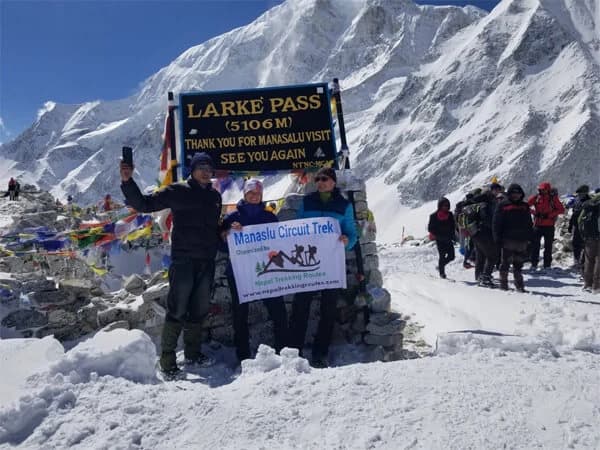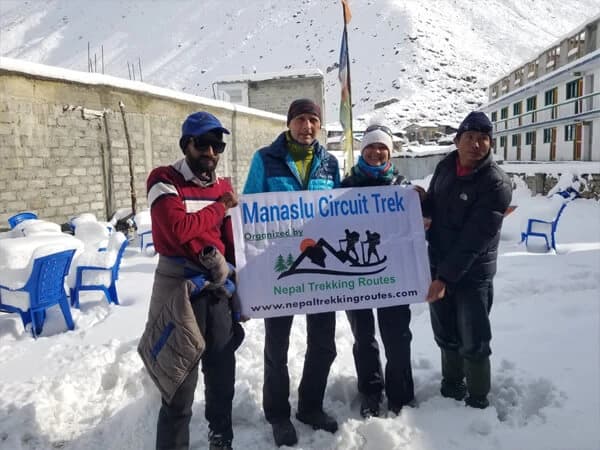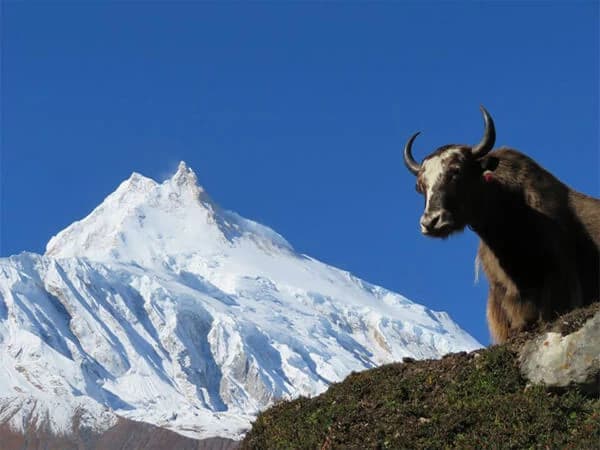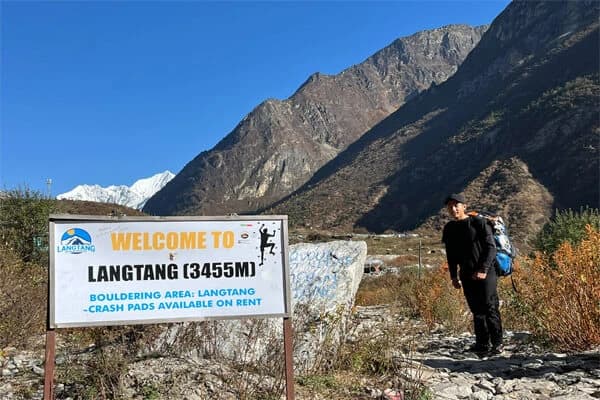The Manaslu Circuit Trek is a thrilling adventure that encircles the World’s eighth-highest mountain, Mount Manaslu (8,163 m). It is a part of the Mansiri Himal located in west-central Nepal. The word Manaslu means “mountain of the spirit”. The majestic mountain peaks, frozen lakes, turquoise glaciers, and high mountain passes are the incredible features of the trek.
It offers an off-the-beaten-path experience than other commercialized treks in the Nepalese Himalayas. It is located in the historical Gorkha district. The route starts from Soti Khola and ends at Besisahar. This lesser-known trek is slowly becoming an alternative to the popular Annapurna Circuit Trek. It lies in the restricted area of the Manaslu region, which was opened to trekkers only after 1990. The region shares its western border with the Annapurna Conservation Area and the north and east border to Tibet.
Manaslu Circuit trek lies in the Manaslu Conservation Area Project (MCAP). It is one of the Himalayan Conservation areas in Nepal that protects the diverse flora and fauna. The trail passes through beautiful villages and Buddhist landmarks which offer cultural and spiritual experiences. The trail has traditional settlements of ethnic communities including Gurungs, Bhutias, Sherpas, and other Tibetan communities.
Highlights of the Manaslu trek
The Manaslu Circuit trek is a hidden gem in Nepal’s Himalayan region. It offers an unparalleled combination of natural beauty and cultural authenticity. It is relatively untouched and preserves its wilderness and unique charm, unlike the other popular trails like Everest and Annapurna.
Breathtaking Natural Beauty
The trek goes around Mount Manaslu providing awe-inspiring views of snow-capped peaks, cascading glaciers, and dramatic landscapes. The journey begins in lush subtropical forests with gorgeous waterfalls and rhododendron blossoms (in spring), gradually moving towards alpine meadows and barren terrains as you ascend. This diversity in scenery makes every day of the trek captivating.
The Larkya La Pass tests the endurance of trekkers and rewards them with panoramic vistas of the Annapurna, Himlung, and Kang Guru ranges. The serene beauty of the turquoise lakes, such as Birendra Tal near Samagaun, and hidden valleys covered in mist are great attractions of the trek.
Cultural Richness and Isolation
The Manaslu region is influenced by Tibetan culture. Remote villages like Lho, Samagaun, and Samdo are home to ancient monasteries. The prayer flags flutter against the mountain backdrops and the locals follow a simple, spiritual way of life. Interactions with the Gurung and Tibetan communities provide a glimpse into a lifestyle deeply connected to nature and Buddhism.
The Manaslu circuit trek has a unique sense of remoteness. The restricted area regulations limit the number of trekkers, so the trail is not so crowded. The solitude allows a deeper connection with the surroundings and a chance to reflect in peace. In some stretches, you may trek for hours without encountering another person. So, it is like a dream come true for those seeking an off-the-beaten-path adventure.
Wildlife and Untouched Wilderness
The trek passes through the Manaslu Conservation Area which protects the diverse flora and fauna of the region. Lucky trekkers might spot elusive wildlife such as the snow leopard, Himalayan thar, or Danfe (the national bird of Nepal). The trek is remote and ecologically significant. The pristine environment and dense forests echo with birdsong.
Physical and emotional journey
The Manaslu Circuit Trek is not just a trek but a journey of personal transformation. The physical challenges of crossing high passes and enduring unpredictable weather build resilience. The beauty of the surroundings creates a profound sense of wonder. Being disconnected from modern conveniences develops mindfulness. You will have a deeper appreciation for the raw simplicity of life in the mountains.
The Manaslu Circuit Trek is a unique combination of beauty and remoteness. It offers stunning landscapes and cultural immersion while restricting commercialization. The Manaslu Circuit Trek is an unforgettable experience for those seeking a Himalayan adventure that feels like traveling back in time.
The purpose of this guide is to outline the challenges and difficulties of the Manaslu Circuit Trek.
What makes Manaslu Circuit Trek Challenging?
The Manaslu Circuit Trek is moderately challenging. Manaslu Circuit Trek difficulty level depends on your physical fitness and experience. It is a high-altitude trek with rugged trails and steep ascents and descents.
A. Altitude
The Manaslu trek altitude challenges start at lower altitudes of around 700m in the subtropical valleys and reaches to the high-altitude Larkya La Pass at 5,213 m. The altitude gain is challenging as well as a thrilling adventure.
Starting Point and Initial Ascents
The trek typically begins in the low-altitude town of Soti Khola (around 710m). The early stages of the trek take you through lush green forests, terraced fields, and roaring rivers. Over the next few days, the trail steadily climbs to villages like Machha Khola (930m) and Jagat (1340 m).
As you move higher, the vegetation changes from subtropical forests to temperate and alpine zones. By the time you reach Namrung (2,660 m) and Lho (3,180m), the air starts to thin, and the dramatic peaks of the Himalayas come into view.
Key High-Altitude Points
The most significant altitude gain occurs as you approach the Tibetan-influenced villages of Samagaun (3,530m) and Samdo (3,860m). These villages serve as important acclimatization stops, giving your body time to adjust to the reduced oxygen level.
The challenge of the trek is crossing the Larkya La Pass. The ascent to this pass is challenging due to the steep climb, cold temperatures, and thin air. However, the panoramic views of the surrounding Himalayan Peaks make the effort worthwhile. After the pass, the trail descends to Bimthang (3,720 m), offering a welcome respite from the high altitudes.
Altitude sickness and its symptoms.
When you trek higher than 2,500m above sea level, you may suffer from altitude sickness. Altitude sickness or Acute Mountain sickness (AMS) is caused by reduced air pressure and lower oxygen levels at high altitudes. The faster you climb to a high altitude, the more likely you will get acute mountain sickness.
You are at higher risk for mountain sickness, if:
- You travel to a high altitude
- You ascend quickly
- You have not acclimatized appropriately to the altitude
- Alcohol or other substances have interfered with acclimatization
- You have medical problems involving the heart, nervous system or lungs
- If you have anemia
The symptoms of altitude sickness depends on the speed of your climb and how hard you push yourself. The symptoms range from mild to life-threatening. They can affect the nervous system, lungs, muscles, and heart. In most cases, symptoms are mild. Symptoms of mild to moderate acute mountain sickness are:
- Difficulty sleeping
- Dizziness or lightheadedness
- Fatigue
- Headache
- Loss of appetite
- Nausea or vomiting
- Rapid pulse or heart rate
- Shortness of breath with exertion
Symptoms that may occur with more severe acute mountain sickness include the following and may progress to High altitude Pulmonary Edema (HAPE) or High Altitude Cerebral Edema (HACE):
- Blue color to the skin
- Chest tightness or congestion
- Confusion
- Cough
- Coughing up blood
- Decreased consciousness or withdrawal from social interaction
- Gray or pale complexion
- Inability to walk in a straight line or walk at all
- Shortness of breath at rest
- To minimize risks, it is essential to follow a well-structured itinerary with gradual ascents, rest days, and plenty of hydration.
Manaslu Trek Acclimatization for a safe trek.
The best way to prevent altitude sickness is to ascend gradually. It is a good idea to spend a few days acclimatizing after ascending to 3000m. Above this point ascend very slowly so that the elevation at which you sleep does not increase more than 300m to 500m per night.
Trekkers should prioritize acclimatization days, such as the one spent in Samagaun. Walking to nearby viewpoints like Manaslu Base Camp (4,400m) during rest days helps prepare the body for higher altitudes.
The significant altitude gain in the Manaslu Circuit trek enhances the sense of adventure and achievement. From lush lowlands to the breathtaking heights of the Larkya La Pass, this variation in altitude creates a diverse and rewarding trekking experience. With proper preparation and acclimatization, trekkers can safely navigate the challenges of altitude and fully enjoy the trek’s beauty and grandeur.
B. Terrain
The Manaslu Circuit Trek is a journey through one of Nepal’s most varied and challenging terrains. The trek stretches across subtropical forests, terraced hillsides, rugged valleys, and high-altitude passes. The diverse landscape offers raw natural beauty but also presents significant physical challenges that require preparation and caution.
Forested lowlands and Hills
The trek begins in the subtropical lowlands of Soti Khola, where lush forests, rice paddies, and flowing rivers dominate the scenery. The trails in this section are generally shaded and humid, with suspension bridges and narrow paths above roaring rivers.
Challenges
- The forested trails can be slippery, especially during the monsoon season, increasing the risk of slips and falls.
- Uneven paths with roots and rocks require constant attention, making this stretch physically demanding despite its relatively low altitude.
- Warm temperatures and high humidity in this region can lead to exhaustion, so make sure you are hydrated.
Ascending through Rugged Valleys
As the trek progresses, the terrain transitions to steep hills and narrow valleys. Villages like Jagat, Deng, and Namrung are located along the ridges connected by steep ascents and descents.
Challenges
- Steep uphill climbs and sharp descents strain the legs, knees, and cardiovascular system.
- The narrow trails often have loose rocks, and crossing these areas is risky.
High-Altitude Alpine Terrain
The terrain in higher-altitude sections, beginning around Lho and Samagau, is alpine. The trees give way to shrubs, grasslands, and barren landscapes surrounded by towering peaks.
Challenges
- As trekkers ascend, the trails become rockier and less defined, requiring careful foot placement.
- The cold and thin air in the alpine zones makes even short uphill sections more exhausting.
The Larkya La Pass
Crossing the Larkya La Pass is the trek’s most challenging and rewarding experience. This section involves steep, snow-covered trails with the risk of altitude sickness looming.
Challenges
- The ascent to the pass is a strenuous climb over loose snow and ice, requiring considerable physical fitness and mental determination.
- Weather conditions can change rapidly, with strong winds and freezing temperatures making the climb difficult and dangerous.
- The descent from the pass is equally challenging, involving a long, steep drop to Bimthang that can be hard on knees and ankles.
Uneven Trails and Long Distances
One of the challenges of the trek is the uneven and unpredictable nature of the trails. From narrow Cliffside paths to rocky moraines and river crossings, the terrain demands constant focus and balance.
Challenges:
- Uneven trails with rocks, boulders, and loose gravel make every step a test of stability.
- Long trekking days, sometimes spanning 6-8 hours, demand physical stamina and mental resilience.
- Trekking poles can reduce some of the strain, but the physical demand remains high throughout the journey.
C. Distance and Duration
The Manaslu Circuit trek takes you through diverse landscapes, remote villages, and high-altitude passes. The total distance of the trek is around 180 km depending on the specific itinerary chosen. The average duration of the trek is around 14-18 days, including time for acclimatization and travel to and from the trailhead.
Typical itinerary breakdown for Manaslu Circuit
-
Preparation and travel: Trekkers often spend 1-2 days in Kathmandu for permits and preparation before traveling to Soti Khola, the trek’s starting point.
-
Trekking days: The actual trekking covers 12-16 days, with daily hiking distances ranging from 10 to 20 km. Most days involve an average walking time of 6-7 hours.
-
Acclimatization and Rest: Acclimatization days, often in Samagaun and other high-altitude locations, are crucial to reduce the risk of altitude sickness.
-
High-Altitude Crossings: The most challenging day is crossing the Larkya La Pass, which requires stamina to climb steep ascents and endurance for the long descent.
-
Return Journey: The trek concludes with a few days of descending toward Dharapani or Besisahar, where transportation back to Kathmandu is arranged.
Stamina and endurance for long treks.
The Manaslu Circuit Trek is a long-distance trekking that demands a combination of physical stamina and mental resilience. Trekkers must be prepared to walk several hours daily, tackle steep ascents and descents, and adapt to varying weather conditions and altitudes. Here’s why stamina and endurance are critical for success:
Sustaining Energy Levels
Covering 10-20 km daily with a backpack requires consistent energy output. Without proper stamina, you will be exhausted, making it harder to complete the day’s journey. The recovery times between days lengthen, disrupting the trek’s schedule. A lack of endurance can increase the risk of injuries like muscle strains or joint pain.
How to build stamina
High-Altitude Challenges
High altitude trekking in Nepal offers adventure seekers the chance to explore some of the world’s highest trails, including Everest, Annapurna, and Manaslu regions. Trekkers experience thin air, stunning mountain views, and unique cultures. Proper acclimatization, permits, and preparation are key to enjoying these challenging but rewarding journeys safely.
Altitude increases physical exertion, making even moderate distances feel more demanding. Stamina is vital for climbing high-altitude villages like Samagaun and crossing the Larkya La Pass. It helps to cope with reduced oxygen levels, which can lead to faster fatigue and difficulty breathing. It is required to maintain a steady pace as overexertion can worsen the symptoms of altitude sickness.
How to manage endurance at high altitudes
- Trek slowly and steadily to conserve energy and allow for proper acclimatization.
- Use acclimatization days to rest, hydrate, and adapt to altitude.
- Focus on nutrition, and eat a diet rich in carbohydrates for sustained energy.
Mental Resilience
Endurance is not just physical, it is also about mental toughness. Trekking in remote areas for days can be mentally exhausting. A strong mindset helps to push through tough days, such as the long climb to Larkya La Pass. It helps to stay motivated despite discomfort or fatigue. You can handle the unpredictability of the trek, from sudden weather changes to minor injuries.
How to build mental endurance
- Break the trek into manageable goals, focusing one day at a time.
- Train in outdoor environments to simulate the mental demands of trekking.
- Trek with supportive guides and companions, like those from Nepal Trekking routes, who provide encouragement and expertise.
Technical Challenges of Manaslu Trek
The technical challenges of Manaslu trek come mainly from its rugged trails, steep ascents, and high-altitude passes. The hardest section is the 5,160-meter Larkya La Pass crossing, which is frequently snow-covered and windy. Careful walking is necessary on narrow, rocky, and occasionally freezing trails. It is more challenging in remote areas because there are fewer facilities and longer walking days. Another issue is altitude sickness, which necessitates appropriate acclimatization. Logistics can be more difficult in the Manaslu region because there are fewer lodges than on more commercial treks. The walk calls for a high level of fitness, endurance, and preparedness for erratic mountain conditions, even if it is not a technical ascent.
D. Weather Conditions
The weather conditions in Manaslu Circuit Trek can be unpredictable and challenging. Understanding how weather impacts this trek and how to prepare for it is essential for a safe and enjoyable journey.
Encountering unpredictable weather
The Manaslu Circuit spans diverse altitudes, from sub-tropical zones to high-altitude mountain passes, resulting in a variety of weather patterns:
- Lower Elevations (Soti Khola to Deng): Expect a warmer climate with occasional rain during the monsoon season. Daytime temperatures are moderate, but mornings and evenings can be chilly.
- Mid-Elevations (Namrung to Samagaun): You will experience cooler temperatures as you climb higher, with a noticeable drop in the evenings. Snowfall may occur in winter and early spring.
- High-Elevations (Larkya La Pass): Weather can change drastically, even within hours. Clear mornings might give way to sudden snowfall, heavy winds or dense fog. Night-time temperatures often drop below freezing.
Unpredictability increases as you ascend near the Larkya La Pass. Trekkers must be prepared for fluctuating conditions regardless of the season.
Impact of bad weather on the trek
Weather impact on Manaslu Circuit difficulty is significant, as conditions vary across seasons. Sudden shifts in weather can significantly affect various aspects of the trek:
Safety Risks:
- Heavy snowfall can make trails slippery and obscure visibility, increasing the risk of accidents.
- In late winter or early spring, malting snow may trigger avalanches on steep sections near high passes.
- Harsh winds and freezing temperatures increase the risk of frostbite and hypothermia at higher altitudes.
Trail Conditions:
- Muddy and slippery trails during the monsoon make trekking slow and physically demanding.
- Rockslides and landslides, often triggered by heavy rain, may block or damage paths in lower sections.
- Accumulated snow can make high-altitude trails impassable in winter.
Disrupted itineraries
- Delays: Unpredictable weather may lead to delays in reaching daily destinations, throwing off the planned schedule.
- Flight cancellations: Flights between Kathmandu and local hubs like Nepalgunj or Juphal can be delayed or canceled due to poor visibility.
Preparation and Planning for Weather Challenges
Each trekking season brings its own weather patterns:
- Spring (March-May): Generally stable with clear skies, though occasional snow in high-altitude regions.
- Monsoon (June-August): Heavy rain increases the likelihood of landslides and leeches on trails.
- Autumn (September-November): The most favorable season with stable weather, crisp air, and excellent mountain views.
- Winter (December-February): Cold, with heavy snowfall at higher elevations, making the Larkya La Pass more challenging.
Gear Up for all conditions:
Carrying the right gear is critical for handling unpredictable weather:
- Clothing: Pack moisture-wicking base layers, insulated jackets, and waterproof outerwear. Layering is key to adapting to changing conditions.
- Footwear: Waterproof boots with good grip ensure safety on wet or snowy trails.
- Accessories: Gloves, a hat, and a balaclava protect against cold, while a poncho or rain cover shields you during rain.
Check Weather forecasts regularly
Before starting your trek, consult trusted weather forecasting services or local guides to understand the upcoming conditions.
During the trek, stay updated on forecasts for specific areas, especially high-altitude sections like Larkya La Pass. Guides from agencies like Nepal Trekking Routes often have real-time weather updates and can adjust itineraries accordingly.
Physical Fitness for Manaslu Circuit Trek
The Nepal Manaslu Circuit Trek requires significant physical fitness and stamina. The steep ascents, rugged trails, and high altitudes are challenging conditions. It is essential to prepare your body for a safe and enjoyable experience.
Navigating Varied Terrain
The trek covers approximately 170 km, with steep ascents, descents and uneven trails. Physical strength and balance are crucial for handling rocky paths, river crossings and Larkya La Pass.
Dealing with altitude
As you ascend to higher altitudes, oxygen levels decrease, making every step more exhausting. Proper fitness improves cardiovascular efficiency, helping you adjust to the thin air and reducing the risk of altitude sickness.
Long Trekking Hours
Trekkers often walk 5-8 hours daily for 12-16 days, depending on the itinerary. A well-prepared body can endure these extended periods of trekking without excessive fatigue or injury.
Preventing injuries
Strengthening your muscles and joints through targeted exercises minimizes the risk of injuries like sprains.
Recommendation on regular exercise routines
Here are some Manaslu trek training tips to get you started:
Cardio training:
Building cardiovascular endurance is essential for the high-altitude trekking environment.
- Activities: Jogging, cycling, swimming, or brisk walking.
- Frequency: 4-5 times a week, gradually increasing the intensity and duration.
- Goal: Achieve the ability to sustain moderate activity for 60 minutes without discomfort.
Strength Training
Developing leg, core, and upper body strength helps manage steep ascents, descents, and the weight of your backpack.
- Leg Workouts: Squats, lunges, and step-ups with weights for added intensity.
- Core Exercises: Planks, crunches, and twists to improve balance and stability.
- Upper body: Push-ups, pull-ups, and dumbbell rows to support carrying your gear.
Flexibility and Balance
Stretching and balance exercises reduce muscle stiffness and improve coordination on uneven trails.
- Yoga: Focus on poses that stretch your hamstrings, calves, and back.
- Balance training: Include exercises like single-leg stands or stability ball exercises.
Hiking Practice
Simulate trekking conditions by practicing with a loaded backpack on varied terrain. This helps acclimate your body to carry weight and walk long distances.
Mental Fitness for Manaslu Circuit Trek
The Manaslu Circuit Trek is not just a test of physical endurance but also a journey that demands mental resilience. Trekkers face long days on the trail, unpredictable weather, and physical fatigue. Mental fitness is critical for completing and enjoying the trek.
Mental challenges of long treks
Isolation and loneliness
While trekking, you will pass through remote landscapes with limited contact with the outside world. The solitude can be both peaceful and daunting during extended sections without interaction with locals or other trekkers.
Monotony of routine
The repetitive daily schedule of trekking, eating, and resting may feel monotonous. Additionally, long hours of walking can be mentally strenuous.
Dealing with Physical discomfort
Sore muscles, altitude sickness, and cold temperatures can take a toll on your mental well-being. Feeling unwell or fatigued often leads to frustration or self-doubt.
Unpredictable Challenges
Weather changes, unexpected delays, or even injuries can disrupt plans, requiring trekkers to stay calm and adapt quickly.
Positive attitude and perseverance
Overcoming Obstacles
A positive mindset can help you navigate challenges such as steep ascents, exhaustion, or adverse weather. Focusing on small wins, like reaching a checkpoint or enjoying a beautiful view keeps morale high.
Managing Stress
Mental preparation helps you cope with unexpected situations. Practicing mindfulness or deep breathing can ease stress and keep you focused on the journey rather than the hardships.
Staying motivated
Remembering why you embarked on the trek, whether for adventure, personal growth, or the beauty of the Himalayas, helps sustain motivation. Encouraging words from fellow trekkers and guides also boost morale.
Building Resilience
Each day on the trail strengthens your mental endurance. Embracing discomfort as part of the adventure builds character and resilience.
Tips for Mental Preparation
- Visualization: Picture yourself completing the trek and enjoying the scenery.
- Set Small goals: Break the journey into manageable sections and celebrate each milestone.
- Stay Connected: Share experiences with fellow trekkers or your guide to feel supported.
- Practice Self-care: Listen to music, meditate, or journal during downtime to refresh your mind.
Tips for Minimizing Manaslu Circuit Trek Difficulty
The Manaslu Circuit Trek is challenging, but with proper preparation and strategic approaches, you can reduce Nepal Manaslu Circuit Trek difficulty. Here are some practical tips on challenges and their solutions:
Altitude Sickness
Solution:
- Acclimatization is key. Plan for rest days at higher altitudes, such as in Samagaun and Dho.
- Stay hydrated and avoid alcohol or caffeine, which can dehydrate you.
- Ascend slowly and listen to your body; descend if symptoms worsen.
Physical Fatigue
Solution:
- Train your body with cardio exercises like running, swimming, or cycling to build stamina.
- Include strength training to prepare your legs and core for steep ascents and descents.
- Practice hiking with a loaded backpack to simulate trekking conditions.
- Take short breaks during the trek to avoid overexertion.
Harsh Weather Conditions
Solution:
- Pack appropriate gear, including waterproof clothing, a high-quality sleeping bag, and layers for warmth.
- Check weather forecasts daily and plan treks accordingly
Navigating Difficult Terrain
Solution:
- Invest in sturdy trekking boots with good grip to prevent slips.
- Use trekking poles for balance and to reduce knee strain on descents.
How to train yourself for this trek?
A structured training plan can significantly enhance your trekking experience. Manaslu Circuit physical preparation includes these exercises before 2-3 months of the trek. Here’s how to train effectively:
Build Cardiovascular Endurance
- Start Early: Begin training at least 2-3 months before the trek.
- Focus on Cardio Workouts: Include running, cycling, swimming, or brisk walking for 30-60 minutes for 4-5 times a week.
- Simulate trek conditions: Gradually add uphill hikes or stair climbing with a loaded backpack to mimic trail challenges.
Strength Training for endurance
- Strong leg, core and shoulders are essential for handling steep ascents, descents and carrying your backpack
- Leg Workouts: Include squats, lunges, step-ups, and calf raises to prepare your lower body.
- Core Exercises: Strengthen your core with planks, Russian twists, and leg raises.
- Upper body: Perform push-ups, pull-ups, and dumbbell exercises to support your backpack.
- Frequency: Aim for 2-3 strength training sessions per week.
Practice Hiking
- Hike with gear: Regularly practice hiking with a 5-10 kg backpack to simulate trekking conditions.
- Weekend Treks: Explore local trails with similar terrain to build confidence and test your endurance.
Improve flexibility and balance
- Stretching: With yoga and stretches enhance flexibility and prevent injuries.
- Balance training: Practice one-leg stand to stabilize yourself on uneven terrain.
Prepare for altitude
- Acclimatization Technique: Learn to pace yourself
- Simulate environments: Use a stair-climber machine or in a high-altitude gym if available.
Mental Conditioning
- Mindfulness and visualization: Practice staying present and visualizing success on the trail.
- Positive Reinforcement: Celebrate small wins during training to stay motivated.
Manaslu vs Annapurna trek difficulty
When comparing Manaslu vs Annapurna trek difficulty, both treks have their own challenges. Many people believe that the Manaslu Circuit Trek is more difficult because it is farther away, less built, and involves longer trekking days. It takes endurance, acclimatization, and mental toughness to traverse the Larkya La Pass (5,160m), and the trails are rugged with steep ascents and descents. Compared to Annapurna, there are less amenities such as teahouses, food, and medical assistance.
However, in terms of infrastructure, the Annapurna Circuit Trek is comparatively simpler. There are many settlements, well-marked routes, and more comfortable teahouses. Though physically taxing and requiring enough acclimatization to prevent altitude sickness, it nevertheless covers the Thorong La Pass (5,416m).
Finally, Annapurna is more approachable but still physically demanding, whereas Manaslu is more untamed and isolated. Comfort-seeking trekkers tend to select Annapurna, whereas wilderness-seekers chose Manaslu.
Conclusion
The Manaslu Circuit trek is one of the most rewarding and challenging treks in Nepal. The high altitude, difficult terrain, long distance, long hiking duration, and unpredictable weather are some of the factors that affect the difficulty of the trek. However, by addressing potential challenges with proper preparation and training, you can make the trek less daunting and more rewarding.
By researching the trek thoroughly and focusing on fitness before the trek and acclimatizing themselves during the journey, trekkers can embrace the challenges of this stunning Himalayan adventure. Rely on experienced guides, like those from Nepal Trekking Routes, who are familiar with the terrain. With a disciplined approach, you’ll be able to tackle the challenges of the Mount Manaslu Circuit trekking and enjoy every step of the journey.
FAQs on Manaslu Circuit Trek difficulty
1. How hard is Manaslu Circuit Trek?
The Manaslu Circuit Trek is moderately to highly challenging. Trekkers face long walking days, steep climbs, remote trails, and high altitude, especially crossing the Larke La Pass at 5,160 meters.
2. What fitness level is required for Manaslu Circuit?
The Manaslu Circuit Trek requires good physical fitness with strong stamina and endurance. Trekkers should handle 6–8 hours of walking daily, steep ascents, and high altitude to safely complete the journey.
3. Do Traveler need trekking experience for Manaslu Trek?
Yes, trekking experience is recommended for the Manaslu Trek, as it involves remote trails, high altitude, and challenging terrain requiring preparation.
4. What are the best time/season for easy Manaslu trekking?
The best time for easy Manaslu trekking is during autumn (September–November) and spring (March–May), when weather is stable, skies are clear, trails are dry, and mountain views are stunning.
5. Is Manaslu Circuit suitable for beginners?
The Manaslu Circuit Trek is generally not recommended for complete beginners due to its remote trails, long walking days, and high-altitude passes like Larkya La (5,160m). However, beginners with good fitness, proper acclimatization, and guidance from experienced trekking agencies like Nepal Trekking Routes can complete it safely and enjoyably.



.webp&w=1200&q=75&dpl=dpl_4U3CaZUV3Y5iKdBNPJmVMATJy3AB)





